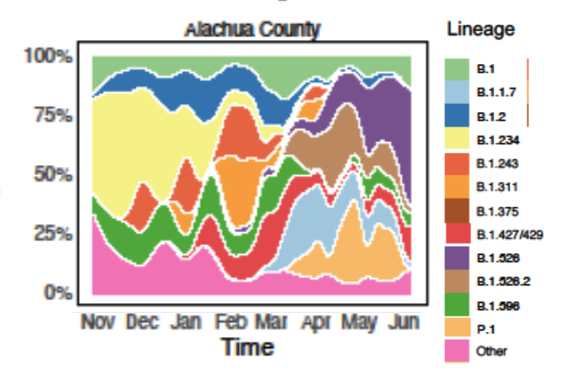
NORRIS – Low-frequency variants in mildly symptomatic vaccine breakthrough infections presents a double-edged sword
Brittany Rife Magalis, Carla Mavian, Massimiliano Tagliamonte, Shannan N. Rich, Melanie Cash, Alberto Riva, Julia C. Loeb, Michael Norris, David Moraga Amador, Yanping Zhang, Jerne Shapiro, Petr Starostik, Simone Marini, Paul Myers, David A. Ostrov, John A. Lednicky, J. Glenn Morris Jr., Michael Lauzardo, Marco Salemi
Article first published online: 20 March 2022
DOI: https://doi.org/10.1002/jmv.27726
ABSTRACT: The emergence of SARS-CoV-2 variants of concern (VOC) has raised questions regarding vaccine protection against SARS-CoV-2 infection, transmission, and ongoing virus evolution. Twenty-three mildly symptomatic “vaccination breakthrough” infections were identified as early as January 2021 in Alachua County, Florida, among individuals fully vaccinated with either the BNT162b2 (Pfizer) or the Ad26 (Janssen/J&J) vaccines. SARS-CoV-2 genomes were successfully generated for 11 of the vaccine breakthroughs, and 878 individuals in the surrounding area and were included for reference-based phylogenetic investigation. These 11 individuals were characterized by infection with VOCs, but also low-frequency variants present within the surrounding population. Low-frequency mutations were observed, which have been more recently identified as mutations of interest owing to their location within targeted immune epitopes (P812L) and association with increased replicative capacity (L18F). We present these results in order to posit the nature of the efficacy of vaccines in reducing symptoms as both a blessing and a curse – as vaccination becomes more widespread and self-motivated testing reduced owing to the absence of severe symptoms, we face the challenge of early recognition of novel mutations of potential concern. This case study highlights the critical need for continued testing and monitoring of infection and transmission among individuals regardless of vaccination status.
Read the full publication at the Journal of Medical Virology.